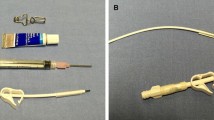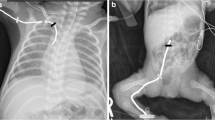Abstract
Objective
To compare the insertion characteristics, utilization profile, life span and the complication rates of Central lines (CL) and Peripherally inserted central lines (PICL).
Methods
A prospective study of all CL or PICL insertions during January 2007 to September 2007 in the Neonatal Surgical Intensive Care Unit of a tertiary care center was done. The number of attempts, procedure time, duration of catheter stay, number of dressing done, complication during insertion and maintenance and cause of removal were noted and the differences analyzed statistically using Pearson chi square / t test. P value. 0.05 was considered significant.
Results
Ninety two neonates were included in the present study of whom 60 were PICL insertions and 32 CL insertions. The two groups were comparable in terms of age, weight and the use of total perental nutrition (TPN) through the catheters. On comparing the PICL and CL groups, the number of attempts for successful insertion (p=0.003), the time taken (p=0.005), the number of dressing changes required during the indwelling period (p=0.005) and the overall complication rates (p=0.002) were significantly less in the PICL group. The PICL could be maintained for longer periods of time (p= 0.005) and only in 11.5% of the patients it had to be removed before completion of therapy as compared to 37.5% early removals for CL (p=0.02)
Conclusion
PICL is a safe, effective and reliable method of providing prolonged IV access in newborns. It also has the least incidence of complications during insertion and maintenance over prolonged period of time when compared to CL and should be recommended for routine use in neonatal surgical patients.
Similar content being viewed by others
References
Merrell SW, Peatross BG, Grossman MD, Sullivan JJ, Harker WG. Peripherally inserted central venous catheters. Lowrisk alternatives for ongoing venous access. West J Med 1994; 160: 25–30
Chlebicki MP, Teo EK. Review of peripherally inserted central catheters in the Singapore Acute-Care hospital. Singapore Med J 2003; 44: 531–535
Hoshal VL Jr: Total intravenous nutrition with peripherally inserted silicone elastomer central venous catheters. Arch Surg 1975; 110: 644–646
Thiagarajan RR, Ramamoorthy C, Gettmann T, Bratton SL. Survey of the use of peripherally inserted central venous catheters in children. Pediatrics 1997; 99: E4
Mazzola JR, Schott-Baer D, Addy L. Clinical factors associated with the development of phlebitis after insertion of a peripherally inserted central catheter. J Intraven Nurs 1999; 22: 36–42. (Errattum in J Intraven Nurs 1999;22:60)
Intravenous Nurses Society: Peripherally inserted central catheters. J Intraven Nurs 1997; 20: 172–174
Tokars JI, Cookson ST, McArthur MA, Boyer CL, McGeer AJ, Jarvis WR: Prospective evaluation of risk factors for bloodstream infection in patients receiving home infusion therapy. Ann Intern Med 1999; 131: 340–347
Jack L, Dolcourt MD, Carl L, Bose MD. Percutaneous insertion of silastic central venous catheters in newborn infants. Pediatrics 1982; 70: 484–486.
Frey AM. Pediatric peripherally inserted central catheter program report: a summary of 4,536 catheter days. J Intraven Nurs 1995;18: 280–291
Rutherford C. A study of single lumen peripherally inserted central line catheter dwelling time and complications. J Intraven Nurs 1988; 11:169–173
Legha SS, Haq M, Rabinowits M, Lawson M, McCredie K. Evaluation of silicone elastomer catheters for long-term intravenous chemotherapy. Arch Intern Med 1985; 145: 1208–1211
Prian GW, Van Way CW 3rd. The long arm silastic catheter: a critical look at complications. JPEN J Parenter Enteral Nutr 1978;2:124. 128
Williams J, Smith HL, Woods CG, Weller PH. Silastic catheters for antibiotics in cystic fibrosis. Arch Dis Child 1988; 63: 658–659
Thiagarajan RR, Bratton SL, Gettmann T, Ramamoorthy C. Efficacy of peripherally inserted central venous catheters placed in noncentral veins. Arch Pediatr Adolesc Med 1998; 152: 436–439
Sheppard R, Ong TH. Evaluation of percutaneously inserted peripheral silicone catheters for parental nutrition in infants and children. Aust Paediatr J 1980; 16: 181–184
Turner MA, Unsworth V, David TJ. Intravenous long-lines in children with cystic fibrosis: a multidisciplinary approach. J R Soc Med 2002; 95(Suppl. 41): 11–21.
Author information
Authors and Affiliations
Corresponding author
Rights and permissions
About this article
Cite this article
Ragavan, M., Gazula, S., Yadav, D.K. et al. Peripherally inserted central venous lines versus central lines in surgical newborns — A comparison. Indian J Pediatr 77, 171–174 (2010). https://doi.org/10.1007/s12098-009-0291-y
Received:
Accepted:
Published:
Issue Date:
DOI: https://doi.org/10.1007/s12098-009-0291-y




